|
|
Ercsam Camex - Model AC - in the original box; ca 1947
It is an unusual camera in many ways:
Presumably it is the first Camex model. Only this model has a name plate mounted on the top of the camera, under the leather strap (the top picture). The lens mount is “H”, as it was in Pathe “H” models. The camera was produced for the English market, as it has standard English tripod tread.
The camera features:
- The viewfinder incorporates two additional optical elements: one for 50 mm telephoto lens and one for Hyper 10 mm wide angle.
- fitted with accidental exposure lock on the continual run position.
- Lens: Cinor Special Berthiot, No 592912; 1:1,9 F= 20 mm;
- Release button for continuous exposure, on the front of the camera. Single frame button on the body side. Rewind crank socket (a key is missing);
- A mechanisms of metric counter showing amount of the film used;
- The spring clockwork motor; non rotating key during filming;
- The Camex charger in the camera, earlier model than ‘DB’ but with similar construction.
Serial production No 2565
|
Ercsam Camex Model AC; in our collection; © Anna Vacani
|
|
|
|
|
|
|
Ercsam Camex - Model V.U - ca 1952
As Grahame L. Newnham B.Sc. writes in ‘A brief History’ on his web site: “In 1946 a new company was formed in Paris - Ercsam... initially with premises at 63 Avenue Philippe Auguste”.
The camera is nicely finished in crystalline gold paint with chrome fittings. The body shape has not changed, as earlier models.
The camera features:
- Lens: SOM Berthiot Paris, No A59146, Cinor C 1: 1,9 F= 20; the interchangeable lens is in a special Camex mount; the lens is bloomed;
- Universal viewfinder lenses built-in the camera. The focus is individually adjustable to (+ - 3 diopter) eyesight, by the ocular ring with engraved sing: ‘+’ ‘0’ and ‘- ‘.
- Parallax optics corrector, corrects accurately referred from 0.50 to infinity, by rotation of two prismatic plates (in the picture - the corrector fitted over the front lens of the viewfinder);
- The adjustment button for the viewfinder is for: 10, 20, 35, 50, 75, 100 and 145 mm (at the top side of the camera);
- The new feature of the camera is a new type of cassette Model DB - visible on the pictures - >
- The mechanism of running film from cassette is completely different from previous cassettes; the cassette was patented. Is made from pressed stainless still. The cassette contains two different compartments, separated by removable metal curtain - opening and closing by a lever placed on a side of the cassette . The chambers are covered by two separated lids.
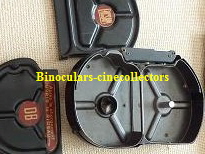 |
The cassette © Anna Vacani
- The speed: 8; 16; 24; 32 fps;
- Release button for continuous exposure, on the front of the camera. Single frame button on the body side. Rewind crank socket (a key is missing);
- The new mechanisms of frame counters, and metric counter showing amount of the film used. The mechanisms are associated together;
- The spring clockwork motor; non rotating key during filming only at the end of the spring.
The picture of our charger with visible opened curtain between chambers, and picture from an Ercsam catalogue - printed in May 1955 - in French language.
Serial production No 21124. |
Ercsam Camex Model V.U in our collection; © Anna Vacani
The cassette construction © Anna Vacani |
|
|
|
|
|
|
Coronet- Model A - 1932
The camera produced in England, by Coronet Camera Co., Birmingham.
The Coronet Camera Co., Birmingham were noted in the market in the 1930s. The prices of these cameras were the lowest of movie cameras, at that time.
It is the most unusual camera in many way:
- The first, the body is made from two different materials: pressed still and Bakelite. The body is covered with an imitation leather. The Bakelite part is like a plate. Into this part is fitted the lens and the front window of viewfinder. The crown emblem is embossed and two words: ‘Fine’, ‘Dull’ on Bakelite. The crown emblem is embossed in the camera door side, as well.
- Next the camera is not fitted with a tripod bush.
- The next important issue, the camera has maltese cross film drive mechanism, which is applied in a few models; no claw mechanism.
- During the war the factory was bombed (optical Department), and after never more was produced the cine items. At this moment only cameras produced before the war are available.
The camera Features:
- The camera runs at one speed only - 16 fps;
- Takes P charger;
- The spring clockwork motor; non rotating key;
- Film footage indicator;
- Lens: Coronet Anastigmat F: 3,9
- Dimensions: 53 x 116 x 145 mm and 1300 g weight.
As a economical crises in Europe, the camera was made very cheaply. Presumably, in years production it was made cheaper and cheaper. In the pictures of two ours cameras, it is visible the release button is different.
Serial production number: 06352
|
Coronet Model A, in our collection; © Anna Vacani
The Maltese Cross intermittent© Anna Vacani |
|
|
|
|
|
|
Coronet-Model A - 1932; in the original box
The camera is in the original leather box, with the Coronet name, on the interior side of the cover.
All camera features the same as above.
Lens: Coronet Anastigmat F: 3,9
Serial production number: 04485
Coronet - Model “C” arrived in the market in September 1938 - without a Bakelite plate surrounding the lens (“Home movies and home talkies”)
|
Coronet Model A, in our collection; © Anna Vacani |
|
|
|
|
|
|
Coronet-Model A - 1932;
All camera features the same as above.
Lens: Coronet Anastigmat F: 3,9
Serial production number: 01920 - it is the earliest production number of in our Coronet collection.
|
Coronet Model A, in our collection; © Anna Vacani |
|
|
|
|
|
|
Coronet-Model B - 1936
The camera produced in England, by Coronet Camera Co., 310, Summer Lane, Birmingham.
The advert of the camera was placed in: “Home Movies And Home Talkies” August 1936 Vol. V, No. 3 edition (in our collection).
It looks as this model was cheaper made than previous models.
The mechanism are the same. Only a few visual features are changed:
- The first, the body is made from pressed still only the Bakelite part is not used. The body is partly covered with an imitation leather - only the sides.
- The lens fitted into the camera is cheaply made, without a name of the producer.
- By the lens is fitted a metal plate with the the crown emblem embossed and the camera name; model and exposure guide.
The crown emblem is embossed in the camera door side, as well.
- A little changed the design of the Maltese Cross intermittent.
The Maltese Cross intermittent © Anna Vacani
Serial production number: 4450 |
Coronet Model B, in our collection; © Anna Vacani
|
|
|
|
|
|
|
Coronet-Model C - 1938
The model C of the camera was produced in England, by Coronet Camera Co., 310, Summer Lane, Birmingham, as well. It was short production before WWII.
The advert of the camera was placed in: Amateur Cine World (ACW) September 1938 edition (copy in our collection). In the next editions of the ACW, it was not anymore advertising of the model C.
It is very collectable camera.
Construction and finish
The body is constructed from pressed sheet metal, covered leatherette. Other parts are finished in black enamel, working parts aluminium and chromium plated. On the top of the camera is fitted a leather handle with embodied word “Coronet”. On the both side of the body are embossed the Company logo and words “Coronet Cine”. In the base of the camera is built in a tripod bush.
Optical System
The lens is an anastigmatic of 27 mm (3.65 m) focal length, fixed focus and aperture f/ 3.9; 5.6; 8;11; 16; 22. Objects from 12 feet to infinity are in focus at all aperture. The lens is not named( op picture).
In the review of the camera published in ACW September 1938 we can read: “The finder is of the straight through tubular optical type and is particularly good, giving a really large bright picture.” After so many years today we can confirm that opinion, it is very bright picture.
External Features
On the left side of the camera is fitted the button for opening the door. On the right side is the winding key (the top picture). Above the key is the footage meter, which does not move progressively, but click over as each unit is reached, giving an audible as well as a visible indication. When the motor is run down somewhat, the camera tends to slow slightly at the moment when the meter operates. The footage meter registers 10 units.
On the opposite side of the footage meter is built in a sliding knob which gives continuos running (C) or single picture movement (S). It is new development in this camera Coronet model C.
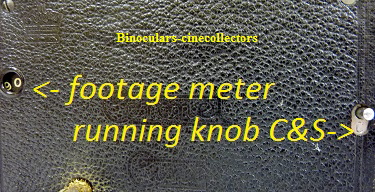
Coronet Model C the right side; © Anna Vacani
On the front face of the camera is a logo of the Coronet Company, size of film 9,5 mm, Model C (op. picture) and are fitted: the viewfinder; the lens; a plate engraved with an exposure guide; the button of the motor control surrounded by a ring marked “Ultra” and “Normal”. The camera speed is not indicated, but are 64 fps and 16 fps. When operating at ultra-speed it is essential to push the button well home, and the motor takes a moment or two to attain full speed.
Type of loading and transit mechanism
The camera is fitted with replaceable 9,5 mm standard type charger of 30 ft film. This type of charger is accommodated in the instrument and the film passes from the top chute of the charger beneath a chromium plated steel strip, over a waisted pulley down past a chromium plated presser pad and then on to an intermittent sprocket operated by a maltese cross movement. The presser pad is channeled. Then the film proceeds down a channel into the bottom chute of the charger.
The shutter appears to be of the revolving disc type, and it is claimed that the special design of the shutter, combined with the maltese cross action, gives greater exposure of the film for a given lens aperture. The film transit mechanism gives very smooth running (op picture).
Accessories
Our camera is in the original box with embodied word “Coronet”. An original small pouch with filters contains 3 filters: 4-6 Ft (portrait filter); Sky filter; 6-12 Ft.(portrait filter).
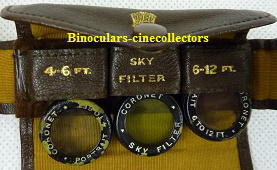 The filters pouch; © A. Vacani The filters pouch; © A. Vacani
The description is partially based on the review of the camera in ACW.
Serial production number: 146C
|
Coronet Model C with original box and filters, in our collection; © Anna Vacani
The front of the camera;© A. Vacani
The charger chamber;© A. Vacani
|
|
|
|
|
|
|
Ditmar - The spool model 1936
The Ditmar Company produced three models of the cameras - 8 mm; 9,5 mm and 16 mm. Each model was produced in many variations. The first models were spool models, next were manufactured cameras taking 30 ft chargers.
Models 9,5 mm were produces with both type of film loading.
In ACW, September 1936 edition, was published an advertisement of two models; 9,5 mm for 30 ft charger; and 8 mm - 25 ft double run film model. Additionally it was announced that “16 mm model available shortly”.
All models were fitted with some variation of lenses:
Cassar ; Berthiot; with aperture of f/1.8; 2.5; 2.8.; 2.9
Next difference among Ditmar Camera models were applied an exposure meters. They were models with an optical or a photocells exposure meters built in alongside the viewfinder and visually linked with the lens aperture scale. It is a simple matter to adjust the exposure without taking the camera from the eye.
Some features are the same in many models. In ACW, September 1936 edition, was published a review of the Ditmar 8 mm camera, it was pointed: ”General Remarks: The other features [...] are exactly similar to the 9,5 mm camera, which was reviewed in the July 1936, issue. They included a special visual film meter and aperture indicator seen through the viewfinder, single picture movement, parallax adjustment on the eye-pice of viewfinder, and two speeds. The claw on the intermittent mechanism is a single one”.
Our camera was produced in 1936, in Austria. That one was manufactured for the market of the countries of the English language and French market. The description in English and French language is visible inside the camera.
The camera is designed very intelligently. Some mechanisms are easy to use. It does not give any problems while in use.
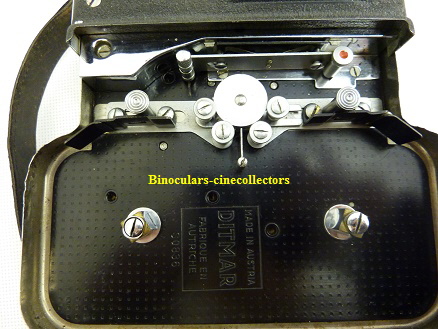
Pict.1;The Ditmar camera 9,5 mm - spool model , interior © Anna Vacani
After 1938 the cameras had description as produced in Germany, when Austria was annexed by Nazi Germany
Camera Features
-Construction and finished
The camera’s body construction is of die casting with a black crackle finish and with chromium fittings.
- Optical System
The lens is Berthiot Paris Cinor Special 1:1.8; F=25m/m; No 296660. It is focusing lens and the scale in two type of measurements - metric in French language and imperial feet.
Into the viewfinder are built in special features, which helped during filming without taking the eye from the viewfinder. Footage indicator and aperture scale are visible in the viewfinder above the picture. In this way the camera is fitted with two footage indicators.
The viewfinder has horizontal parallax adjustement by sliding eyepice. The eyepiece of the viewfinder has two settings:
- for distant shots at more than 2 yards - the eyepiece is fully opened and the picture in the viewfinder is unobstructed see.
- for close-ups taken at a distance of less than 2 yards. The eyepiece must be pushed fully to the right and the red dot, on the plates guides appeared. The picture in the viewfinder appears partially colored.
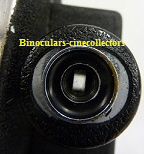 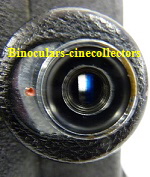
Pict.5;The viewfinder for distant shot Pict.6; for close-ups pictures © Anna Vacani
- Type of loading and transit mechanism
The camera is taken 50 ft - 15 meters film spool. Loading the camera by means of daylight spools:
Place the spool on the right spindle (Pict.1)so that the film unwinds in a clockwise direction and consequently the cut-outs in the spool center portion snaps on the tooth.
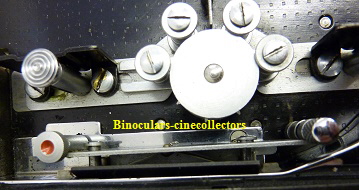
Pict.7; The film pressure pad and pressure rollers closed; © Anna Vacani
The film pressure pad must be slide back and the pressure rollers as well. See these position in the bellow picture.
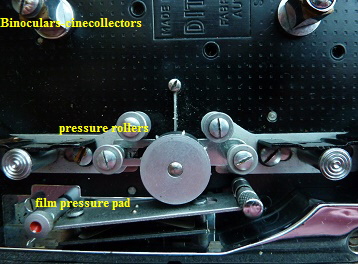
Pict.8; The film pressure pad and pressure rollers opened; © Anna Vacani
After the threading of the film you need to close the film pressure pad and the loops forming rollers. One loop around of each side of the film pressure pad buttons. Close the pressure rollers. Press the release button 16 fr/sec to test whether film moves correctly.
Close the door of the camera and set the footage indicator -Pict3. Pull out the footage indicator knob and rotate until the cross sign marked upon it is facing the footage indicator index (a small hole by the footage indicator). Run the film lead by pressing button for 16 fr/sec until the figure O is facing the footage indicator index.
- Speed
The camera is fitted with separate buttons for 16 and 32 frames per second. Either speed selected instantly. The buttons are placed in front of the camera (Pict. 2). In the picture 3, is visible a button for continuos running, it has a red dot. The button has to be turned on right for continuos filming. Bellow this butt on is hand crank for a single picture.
- Motor and mechanism
The camera is fitted with a spring motor. Wind up the spring by turning the key clockwise. The key is non rotating.
The serial production number: No S083 6
|
Pict.2;The Ditmar camera 9,5 mm - spool model, the front side © Anna Vacani
Pict.3;The Ditmar camera 9,5 mm - spool model, the side © Anna Vacani
Pict.4;The Ditmar camera 9,5 mm - spool model, the side © Anna Vacani
|
|
|
|
|
|
|
Ditmar - The photocell Model - 1936 - 1939
This model has a built-in photoelectric cell which shows in the viewfinder the aperture required at any moment. By keeping the aperture indicator at the same reading as a photoelectric cell perfect exposure can be secured every time.
The aperture is controlled by a slide button and an indicator showing the aperture in use is constantly visible in the viewfinder.
Provision is also made for adjusting the photocell to various film speed. Either 16 or 32 fps is instantly selected by pressing the appropriate button.
The camera body is black leather-grain finish with chromium fittings.
The camera features:
- Separate control buttons for 16 and 32 fps - allowing for instant selection of speed (two chromium buttons, at the front - in the picture);
- Slide control for lens aperture permits adjustment even while actually filming. Indicator shows in viewfinder (at the edge on the side camera - in the picture);
- Sliding eyepiece to viewfinder - to the left or right - eliminates horizontal parallax on close-up. Vertical parallax nonexistent.
- Hand crank for a single picture ( at the bottom corner in the picture);
- Continuos running device;
- Ditmar charger in the camera;
- Lens: Berthiot Paris Cinor; No 325831; 1:1,8, F=25mm
- The Ditmar cassette in the camera.
Made in Austria by: Ditmar R. Gebrüder Brünner AG, Vienna, Austria.
Serial production number : K4221
|
|
|
|
|
|
|
|
Ditmar - Model with built-in optical exposure meter - 1936
In the viewfinder is visible, above the picture, a stepped wedge giving the range of densities; the aperture control is moved until the its indicator in the viewfinder corresponds with the darkest step just visible, the exposure will then be correct. A special pin on the aperture slide obscure the viewfinder during the setting so as to ensure accurate results, and device is included to adjust the meter for varying film speeds;
The camera features are the same as above.
- Lens: Berthiot Paris Cinor; No 297884; 1:2.8, F=20
The Ditmar cassette in the camera.
Made in Austria by: Ditmar R. Gebrüder Brünner AG, Vienna, Austria. .
Serial production number K3374
|
|
|
|
|
|
|
|
Ditmar - The Photocell Model - 1936 - 1939
This model is slightly different then above photocell model. The body design is partly different as the chamber of the camera is much bigger. It is a spool model.
The eye lens of the viewfinder looks like a tube (the top picture). Next different feature of the body is the tripod socket is fitted on an extension to the base of the film housing container .
Lens: 1: 1,8/ F= 25 mm; SOM Berthiot Paris Cinor Special - focusing lens.
The camera features are the same as above photocell model.
The different camera features:
- 50 ft spool loading;
- sprocket feed;
Made by Ditmar R. Gebrüder Brünner AG, Vienna, Austria.
The serial production number: No S1237.
|
|
|
|
|
|
|
|
Nizo - Model F - 1929
The camera is very rare, fitted with interchangeable lens - Kino Plasmat: f 1,5 Foc 1 inch, Pat. Dr Rudolph; made by Hugo Meyer & Co Görlitz No 581735. The lens is in a special bayonet mount. This lens Kino Plasmat was the fastest speed lens, and very famous, produced in the world at the time. Our camera has a Dallmeyer Popular telephoto lens: F/4, F= 3”; No 176866, as well, with the same kind of mount. *
In 1918 Dr Paul Rudolph, the inventor of Zeiss Tessar, developed Meyer’s Double Plasmat (which was derived from Meyer’s symmetrical Euryplan lens). In the 1926 he developed fast variants, the Kino Plasmat f/2 and the World’s fastest lens of its time, the Kino Plasmat f/ 1,5.
In the: Hugo Meyer & Co. - “A catalog of Lenses and Other Accessories for Cinematographers” - published in N.Y. 1930, it was told: “This lens has won world wide recognition for its greater depth of focus and absence of flare.... The enormous speed of the F: 1, 5 Kino Plasmat almost 6 times as fast as F: 3, 5 - enables you, with this lens on your camera, to get pictures when your slower lens would be useless.”
The camera features:
- The shutter release button is fitted in different place than others cameras, at the time, at the rear back of the camera; above the release button is placed a film counter for 9 meters of film;
- The spring clockwork motor; non rotating key;
- Speed: 16 and 32 fps only;
- A detachable hand for handle cranking or back winding of film (detached to the camera in the picture);
- The camera takes “P” charger.
Made by Niezoldi & Krämer GmbH (Nizo), München, Germany.
The serial production number: 203410.
* These Kino Plasmat lenses are very desirable and fetched a lot of money, as $1995.
|
|
|
|
|
|
|
|
Nizo - Model F - 1929
It is the same model as one described above. This camera is fitted with a different lens. It is not interchangeable lens - Steinbeil München Cassar; 1:2,8; F=2 cm; No 258272.
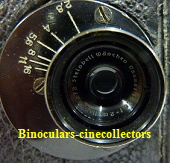 Steinbeil München Cassar lens in our camera;© Anna Vacani Steinbeil München Cassar lens in our camera;© Anna Vacani
The camera features:
- The shutter release button is fitted in different place than others cameras, at the time, at the rear back of the camera; above the release button is placed a film counter for 9 meters of film;
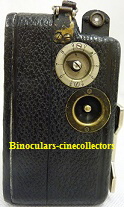 Pict. 2; Film counter & the release button;© Anna Vacani Pict. 2; Film counter & the release button;© Anna Vacani
- The spring clockwork motor; non rotating key;
- Speed: 16 and 32 fps only; the button in the below picture (top left hand site) is rotated anti clockwise to lock the starter button to continuous run. Press the button and turn anti clockwise.
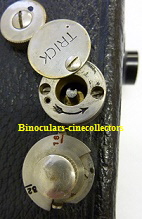
Pict. 3; Speed adjustement & cranking or film back winding attachment; © Anna Vacani
- A detachable hand for handle cranking or back winding of film (detached to the camera in the picture in above model) is missing with this camera.
- The camera takes “P” charger.
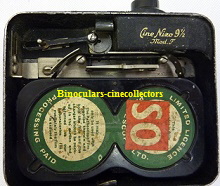
Pict. 5; “P” charger threaded into camera © Anna Vacani
The camera’s threading path can be ease cleaned with the gate fully opened.
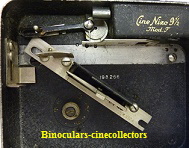
Pict. 6; The gate is opened for cleaning; © Anna Vacani
The camera was produced by Niezoldi & Krämer GmbH (Nizo), München, Germany.
The serial production number: 198266
|
Pict 1; Nizo Model F; © Anna Vacani
Pict. 4; Nizo Model F, back side; © Anna Vacani |
|
|
|
|
|
|
(1) (2) (3) (4) (5)
|
|
|
|
Page Back
|
|
|